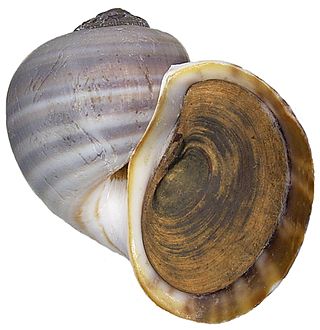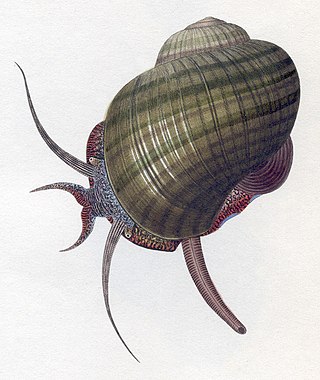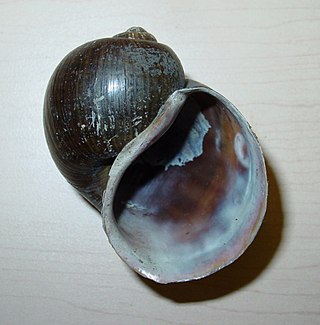
Ampullariidae, whose members are commonly known as apple snails, is a family of large freshwater snails that includes the mystery snail species. They are aquatic gastropod mollusks with a gill and an operculum. These snails simultaneously have a gill and a lung as functional respiratory structures, which are separated by a division of the mantle cavity. This adaptation allows these animals to be amphibious. Species in this family are considered gonochoristic, meaning that each individual organism is either male or female.

Pila is a genus of large freshwater snails with an operculum, African and Asian apple snails, aquatic gastropod mollusks in the family Ampullariidae, the apple snails.

Pila ampullacea, is a species of freshwater snail with an operculum, an aquatic gastropod mollusk in the family Ampullariidae, the apple snails.

Pomacea is a genus of freshwater snails with gills and an operculum, aquatic gastropod mollusks in the family Ampullariidae, the apple snails. The genus is native to the Americas; most species in this genus are restricted to South America.

Pomacea canaliculata, commonly known as the golden apple snail or the channeled apple snail, is a species of large freshwater snail with gills and an operculum, an aquatic gastropod mollusc in the family Ampullariidae, the apple snails. South American in origin, this species is considered to be in the top 100 of the "World's Worst Invasive Alien Species". It is also ranked as the 40th worst alien species in Europe and the worst alien species of gastropod in Europe.

Pomacea diffusa, common name the spike-topped apple snail, is a species of freshwater snail, an aquatic gastropod mollusk in the family Ampullariidae, the apple snails.

Pomacea paludosa, common name the Florida applesnail, is a species of freshwater snail with an operculum, an aquatic gastropod mollusk in the family Ampullariidae, the apple snails.

Pomacea maculata is a species of large freshwater snail with an operculum, an aquatic gastropod mollusk in the family Ampullariidae, the apple snails.
Pomacea aurostoma is a South American species of freshwater snail with gills and an operculum, an aquatic gastropod mollusc in the family Ampullariidae, the apple snails.
Pomacea baeri is a South American species of freshwater snail with gills and an operculum, an aquatic gastropod mollusc in the family Ampullariidae, the apple snails.
Pomacea hollingsworthi is a South American species of freshwater snail with gills and an operculum, an aquatic gastropod mollusc in the family Ampullariidae, the apple snails.
Pomacea quinindensis is a South American species of freshwater snail with gills and an operculum, an aquatic gastropod mollusc in the family Ampullariidae, the apple snails.

Pomacea columellaris is a South American species of freshwater snail in the apple snail family, Ampullariidae.

Pomacea decussata is a species of freshwater snail in the family Ampullariidae.
Pomacea comissionis is a species of freshwater snail in the family Ampullariidae. It was first described by Hermann von Ihering in 1898 as a variety of Ampullaria decussata.
Pomacea auriformis is a species of freshwater snail in the family Ampullariidae, described by Lovell Augustus Reeve in 1856 as Ampullaria auriformis. Its distribution is along the Caribbean coast of Central America. There has been debate over whether this species may be a subspecies of Ampullaria hopetonensis.
Pomacea ocanensis is a species of freshwater snail in the Ampullariidae family native to Colombia. Wilhelm Kobelt originally described the species as a subspecies of Ampullaria auriformis in 1914. A critically endangered species, P. ocanensis faces threats of declining habitat quality due to urbanization, local water management, and pollution. It is the only member of Pomacea considered Endangered or Critically Endangered by the IUCN and one of only two Ampullariids to be Critically Endangered.
Pomacea occulta is a species of freshwater snail in the family Ampullariidae. Previously misidentified as the cryptically similar Pomacea maculata, P. occulta was differentiated by Yang et al. in 2019 using DNA barcoding and molecular systematics.

Pomacea fasciata is a freshwater snail in the Ampullariidae family. It is located in Jamaica, Guadeloupe, and Hispaniola. It lays white eggs.
Pomacea prunella is a species of freshwater snail in the family Ampullariidae, native to Brazil. They have also been found in French Guiana. Unlike other New World Ampullariids, P. prunella has a calcified, rather than corneous, operculum.










